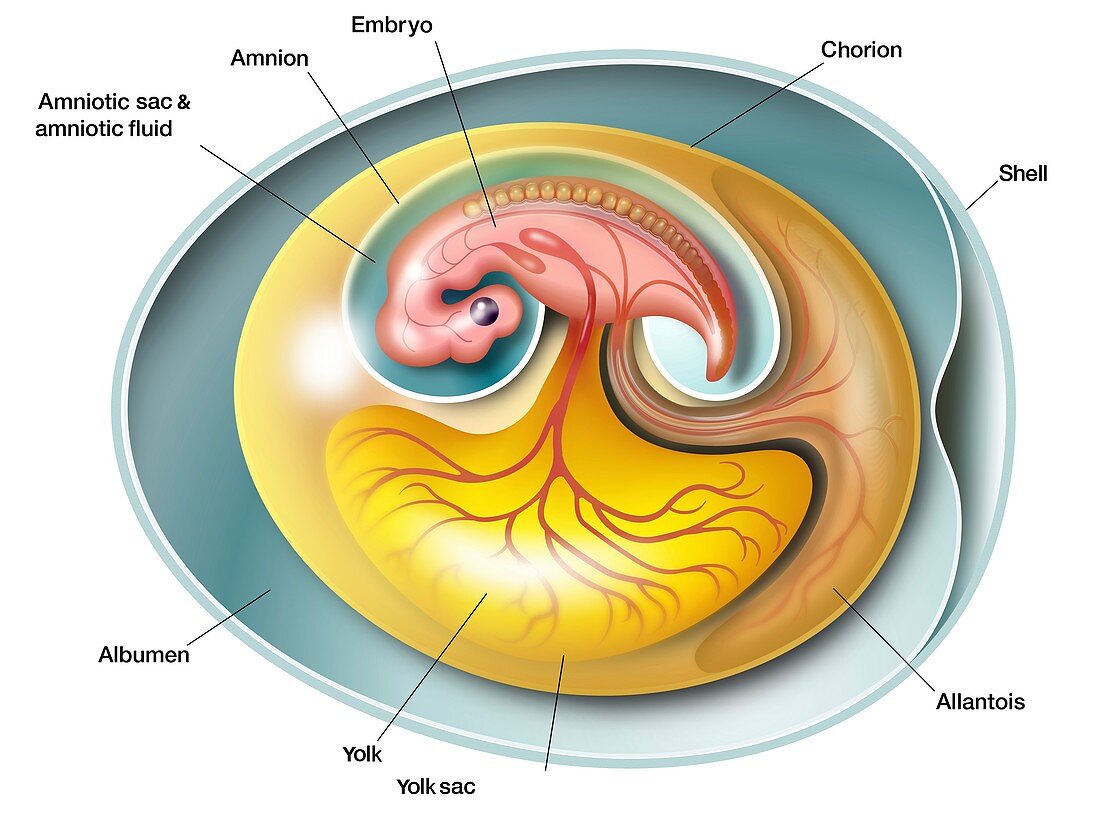Amniote embryo anatomy, illustration
Bildnummer 12490778

| Amniote embryo anatomy. Illustration of the anatomical features common to the embryos of all amniotes. The amniotes are the tetrapod vertebrates: reptiles, birds, and mammals. The developing embryo (formed during sexual reproduction) is surrounded by an amniotic sac and amniotic fluid, encased in a membrane called the amnion. The embryo is nourished by the yolk, contained in its yolk sac. The allantois is a structure used to exchange gases and handle liquid waste. Surrounding all these structures is another membrane, the chorion. The albumen is the egg white (found in the eggs of birds and reptiles). Both the albumen and the outermost shell are different in structure (or absent) in mammals, where the embyro implants in the uterus rather than developing inside a shell. The evolution of the amniote embryo enabled the move from water to land, avoidnig the need to lay eggs in water. | |
| Lizenzart: | Lizenzpflichtig |
| Credit: | Science Photo Library / JOSE ANTONIO PENAS |
| Bildgröße: | 8403 px × 6250 px |
| Modell-Rechte: | nicht erforderlich |
| Eigentums-Rechte: | nicht erforderlich |
| Restrictions: | - |
Preise für dieses Bild ab 15 €
Universitäten & Organisationen
(Informationsmaterial Digital, Informationsmaterial Print, Lehrmaterial Digital etc.)
ab 15 €
Redaktionell
(Bücher, Bücher: Sach- und Fachliteratur, Digitale Medien (redaktionell) etc.)
ab 30 €
Werbung
(Anzeigen, Aussenwerbung, Digitale Medien, Fernsehwerbung, Karten, Werbemittel, Zeitschriften etc.)
ab 55 €
Handelsprodukte
(bedruckte Textilie, Kalender, Postkarte, Grußkarte, Verpackung etc.)
ab 75 €
Pauschalpreise
Rechtepakete für die unbeschränkte Bildnutzung in Print oder Online
ab 495 €
Keywords
- Amnion,
- Anatomie,
- anatomisch,
- ausgeschnitten,
- Ausschnitte,
- beschriftet,
- Biologie,
- biologisch,
- Eigelb,
- Eiweiß,
- Embryo,
- Embryologie,
- Entwicklungsbiologie,
- Etikette,
- Etiketten,
- Fauna,
- Illustration,
- Kunstwerk,
- Membran,
- Natur,
- Niemand,
- Reproduktion,
- reproduktiv,
- Reptil,
- Säugetier,
- Schale,
- Text,
- Tier,
- Vogel,
- weißer Hintergrund,
- Zoologie,
- zoologisch
